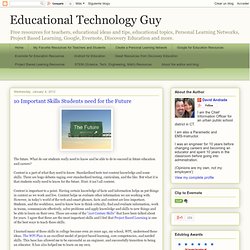

Welcome to CK-12 Foundation. Utah Core Standards. Interactives. QR Codes In Education. 20 Must-See Teaching Tools Coming To Your Classroom Very Soon. It’s hard to find a field that hasn’t been radically changed by technology, and education is no exception.
Few classrooms these days operate without digital tools, gadgets, or applications that have made it easier for teachers to track student progress and tailor lessons to student needs and interests. While the tools of today are great, there are even more great technological teaching tools and practices on the horizon, many of which are just starting to be adopted in the classroom or are just making it out of the developmental stages. These tools offer new and often very promising ways to connect with students and improve the quality of education offered in schools. Read on to learn about just a few of the websites, programs, and amazing technologies of the future teachers and students alike will soon be using. (Click the title of each tool to visit their respective website) ClassConnect 19Pencils Augmented Reality Glasses Online Learning Exchange Prentice Hall Writing Coach Three Ring Lore.
Education - Challenge Based Learning. 10 Important Skills Students need for the Future. The future.

What do our students really need to know and be able to do to succeed in future education and careers? Content is a part of what they need to know. Standardized tests test content knowledge and some skills. There are huge debates raging over standardized testing, curriculum, and the like. But what it is that students really need to know for the future. Content is important to a point. I learned many of these skills in college because even 20 years ago, my school, WPI, understood these ideas. Research by the Institute for the Future released in a report entitled “Future Work Skills 2020″ shows that preparing for a specific career area based on content is difficult and, instead, people should be developing certain broad skills.
Here are the skills: Sense-making. Social intelligence. Novel and adaptive thinking. Cross-cultural competency. Computational thinking. New-media literacy. Transdisciplinarity. Cognitive load management. Virtual collaboration. Leading a transformation in research communication. 50 QR code resources for the classroom. Google for Education Resources. Google for Education Resources Why and How to Use Google in Education: Free (or really cheap for Apps for Education compared to Microsoft) and less IT support needed.

Also runs better on older computers. I recommend using Chrome browser too. Easy to use - students and teachers probably use some of it already All work together - all the apps work together and have similar menus and functions Cloud based - backed up on Google’s servers, accessible from any computer and mobile device, runs fast, no lost flash drives or corrupted drives. Google Apps for Business offers 25GB of email storage per user, a 99.9% uptime guarantee, data migration capabilities, advanced management tools, telephone support, added security features and more, all for $50 per user per year. Resources to Replace Textbooks. "Beyond Textbooks" is a well used mantra by educational technology companies and districts who are moving away from traditional print textbooks to digital media and resources. I don't use a textbook with my Physics classes for many reasons: the textbooks are old and outdated (but in good physical condition), the textbooks are hard to read, they are heavy, and they don't have any way to get help or expand on the material.
I use a variety of materials with my Physics classes in place of the textbooks. I use Blogger and Google Sites to create a class blog and class website. The blog is where I post assignments, information, reminders, and more and the site has links, downloads, and other information. For class materials that replace a textbook, I use: Handouts with summary of concept, example problems, and problem sets for students to complete.